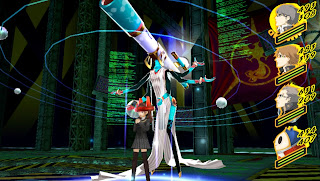There is something very Tim Burtonesque running behind Persona 4. On the one hand players experience the banality of life in a small Japanese village. Children watch TV. Incessant rain boxes people indoors. Families complain that a big shopping mall is driving the local businesses out of town.
And then there’s the other world, where nightmares are the name of the day and every creature and location is overridden for pure sinister intent by the next. It’s a world where players encounter their literal dark sides and running underneath that near-horror theme is a game that asks some very uncomfortable questions regarding modern social interactions and relationships.
And by the same token there are moments of such complete, weird, innocence that it’s surprising that Burton hasn’t asked for the rights to make the film yet. Teddy, the ghost bear adviser and ally, is so completely cute that he looks like he belongs in a Pokemon game. For every enemy that is a complete perversion of sexual attractiveness or revulsion against those that love violence is an enemy that you just want to pick up and cuddle. It’s not a unique contrast for Japanese anime and manga – Gregory Horror Show being the pinnacle of this theme – it remains a compelling approach to storytelling.
Persona 4 is so thematically dense that it takes its time to make its point. The first real fight in this JRPG is a solid three and a half hours after “New Game” has been selected. The game only exits out of its tutorial and opens up into the main game at about the five hour mark. Getting to the game’s finale and seeing enough to be happy with what you’ve done is around 80 hours of work. That’s for the PS2 original game. This port has additional features to extend the length even further.
What’s amazing about Persona 4 is that that length doesn’t feel like it’s been padded out in any way. The developers knew that they had a strong story going into this game, and the ensuring plot plays out in a confident, refined fashion. It’s perfect proof that JRPG genre can create a compelling story, and that linear stories can play a role in videogames.
Of course, if I was looking for a good story, I could get a book – a great game story needs some kind of interactive hook to really pull players in. A JRPG that asks for 100-odd hours of a player’s life? There’s a time investment in this kind of game that a developer really does need to provide a great deal of respect to its players to be worthy of.
Contrary to many people, who label this game as one of the finest examples of the genre ever, I don’t necessarily think Persona 4’s JRPG elements are much more than ‘merely’ being really well-refined. All Persona games are challenging and require players to understand the strengths and weaknesses of their enemies more than their character’s own skills, and this one is no different. It’s a nice change to the usual JRPG fare where a properly tweaked party of heroes can overwhelm almost any enemy to be unable to simply grind to victory with harder encounters, but its a subtle enough shift in focus that it’s far from revolutionary.
The turn-based combat focuses on the use of “Personas” – equipable monsters that provide players with different skills, depending on which Persona is equipped. It’s a simple system but coming up with the right group of Personas to handle the wide range of enemies that are thrown at players. But, again, it’s not something we haven’t seen before in other JRPGs.
Where Persona 4’s innovations do come in are in the social interactions and how those link into the combat. Players are encouraged to do more than delve through dungeons in this game – by strengthening friendships with other NPCs, a player “levels up” their social interaction scores. This doesn’t have a direct impact on the player, but leads to more powerful Personas in combat. In execution it’s a wonderfully balanced system of risk and reward. Because the game itself has strict time limits to achieve things, players need to balance the desire to complete important quests with the need to be socially active in order to be powerful enough to tackle the important quests.
It’s very nearly a metaphor and parable for real life. The game is telling us that without being an active part of the real world, being successful enough to achieve anything genuine is impossible. The metaphor becomes even more compelling when you consider that the link between the real world and the monsters in Persona 4 is a TV – a less-than-subtle comment by the developers that the real key to success in life is in the real world, rather than visual fantasies.
And that brings me right back to the Burtoneque nature of Persona 4. It’s a modern-day fairy tale. It makes a very serious and downright philosophical point, but in such an engaging and entertaining way that you might not even realise you’re being lectured. And, while I strongly contest any notion that this is one of the greatest JRPGs of all time, it’s certainly the best Persona game, belongs squarely in the top tier of the genre, and is worth buying a Vita for.
– Matt S
Find me on Twitter: @digitallydownld












